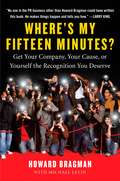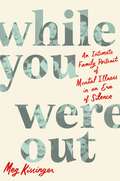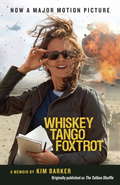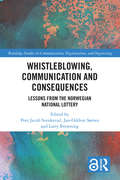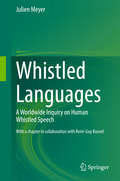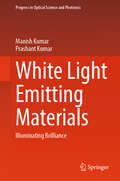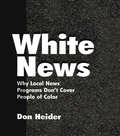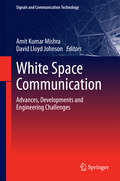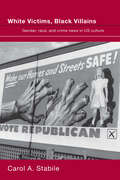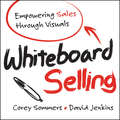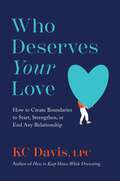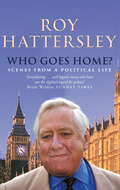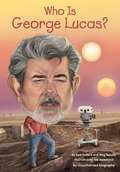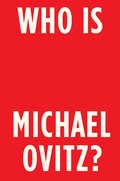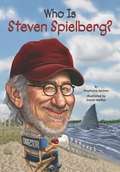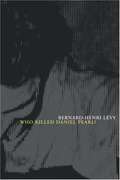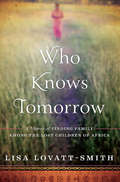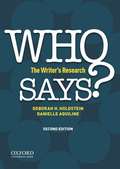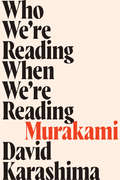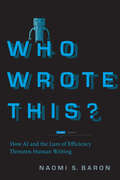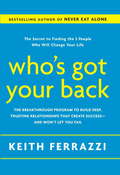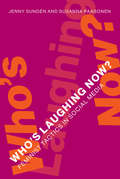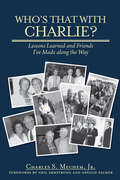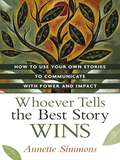- Table View
- List View
Where's My Fifteen Minutes?: Get Your Company, Your Cause, or Yourself the Recognition You Deserve
by Howard BragmanMedia attention can boost careers, generate millions of dollars, and make dreams come true. It can also destroy reputations and derail carefully laid business plans.<P><P> All publicity is not good publicity.No one knows this better than Howard Bragman. For more than thirty years he has helped prominent people--movie stars, business leaders, philanthropists-- get their messages out, in good times and bad.His book won't make anyone famous overnight, but it will help readers understand the changing world of today's PR.<P> If your public's perception doesn't match reality--if you are a better person, offer a better product, or stand for a better cause than anyone realizes-- you need help. Bragman shows how to: <P>Understand your real target audience <P>Respect what the media needs and wants <P>Give memorable interviews, even during a crisis <P>Handle the new challenges of the Internet age.<P>He illustrates his lessons with juicy examples, from Frank Sinatra and Madonna to Coca-Cola and Monica Lewinsky. Whether you're trying to build a business, advance your career, or change the world, there's much to be learned from Bragman's insights and experience.
While You Were Out: An Intimate Family Portrait of Mental Illness in an Era of Silence
by Meg KissingerFrom award-winning journalist Meg Kissinger, a searing memoir of a family besieged by mental illness, as well as an incisive exploration of the systems that failed them and a testament to the love that sustained them.Growing up in the 1960s in the suburbs of Chicago, Meg Kissinger’s family seemed to live a charmed life. With eight kids and two loving parents, the Kissingers radiated a warm, boisterous energy. Whether they were spending summer days on the shores of Lake Michigan, barreling down the ski slopes, or navigating the trials of their Catholic school, the Kissingers always knew how to live large and play hard.But behind closed doors, a harsher reality was unfolding—a heavily medicated mother hospitalized for anxiety and depression, a manic father prone to violence, and children in the throes of bipolar disorder and depression, two of whom would take their own lives. Through it all, the Kissingers faced the world with their signature dark humor and the unspoken family rule: never talk about it.While You Were Out begins as the personal story of one family’s struggles then opens outward, as Kissinger details how childhood tragedy catalyzed a journalism career focused on exposing our country’s flawed mental health care. Combining the intimacy of memoir with the rigor of investigative reporting, the book explores the consequences of shame, the havoc of botched public policy, and the hope offered by new treatment strategies. Powerful, candid and filled with surprising humor, this is the story of one family’s love and resilience in face of great loss.
Whiskey Tango Foxtrot (The Taliban Shuffle MTI)
by Kim BarkerNow a Major Motion Picture titled Whiskey Tango Foxtrot starring Tina Fey, Margot Robbie, Martin Freeman, Alfred Molina, and Billy Bob Thornton. From tea with warlords in the countryside to parties with drunken foreign correspondents in the "dry" city of Kabul, journalist Kim Barker captures the humor and heartbreak of life in post-9/11 Afghanistan and Pakistan in this profound and darkly comic memoir. As Barker grows from awkward newbie to seasoned reporter, she offers an insider's account of the region's "forgotten war" at a time when all eyes were turned to Iraq. Candid, self-deprecating, and laugh-out-loud funny, Barker shares both her affection for the absurdities of these two hapless countries and her fear for their future stability.
Whistleblowing, Communication and Consequences: Lessons from The Norwegian National Lottery (Routledge Studies in Communication, Organization, and Organizing)
by Peer Jacob Svenkerud; Jan-Oddvar Sørnes; Larry BrowningWhistleblowing, Communication and Consequences offers the first in-depth analysis of the most publicized, and morally complex, case of whistleblowing in recent European history: the Norwegian national lottery, Norsk Tipping. With contributions from the whistleblower himself, as well as from key voices in the field, this book offers unique perspectives and insights into not only this fascinating case, but into whistleblowing and wrongdoing in organizations more broadly. An international team of scholars use fourteen different theoretical lenses to show the complex and multi-faceted nature of whistleblowing. The book begins with an ethnographic account by the whistleblower story and proceeds into an analysis of the literature and conceptual topics related to that whistleblowing incident to present the lessons that can be learnt from this extreme example of institutional failure. This fascinating, complex, and multi-theoretical book will be of great interest to scholars, students and industry leaders in the areas of public relations, corporate communication, leadership, corporate social responsibility, whistleblowing and organizational resistance.
Whistled Languages
by Julien MeyerThe main focus of this monograph on whistled speech is the result of a worldwide inquiry primarily based on the author's unprecedented fieldwork and laboratory experience. The different questions raised by the origin and the evolution of whistled forms of languages are also explored, including the role of environmental constraints in the emergence of whistled speech, their phonetic and phonological typology, the cognitive processing of whistled signals, monogenesis and polygenesis scenarios, the hypothesis of a whistled system preceding voiced speech, the intricate relationship between music and language in whistling, and the convergence/divergence with whistled communication among animals (birds, dolphins and primates). This book also includes several documents and a chapter prepared in collaboration with René-Guy Busnel, a pioneer in the studies of whistled forms of languages who has worked with five different populations using whistled speech (from the late 60s to the early 90s). The author has been intensively studying this fascinating language practice for the past 12 years, including 30 months of onsite research in collaboration with the cultural representatives of approximately twenty linguistic communities around the world. Whistled speech represents an ancient traditional telecommunication system that has survived on all inhabited continents of our planet. In it, a whistle replaces the voice and carries the information. However, this practice does not replace ordinary speech but is used in a complementary way. It serves to increase the audible range, but also under certain circumstances, the degree of secrecy of spoken communications. Whistled speech is adapted to the structure of each language, to specific traditional rural activities such as hunting or shepherding, and to specific ecological milieux. It is today a severely endangered speech register that provides an alternative insight into the nature of human language.
White Light Emitting Materials: Illuminating Brilliance (Progress in Optical Science and Photonics #31)
by Manish Kumar Prashant KumarThis book offers an in-depth exploration of the rapidly evolving field of luminescent materials that hold the key to energy-efficient lighting and advanced display technologies. This book delves into the synthesis, characterization, and application of white light-emitting materials, ranging from organic and inorganic compounds to cutting-edge nanomaterials like quantum dots and carbon-based nanostructures. Through comprehensive discussions on the underlying photophysical mechanisms and emission properties, this volume provides valuable insights into the science driving innovation in solid-state lighting and optoelectronics. This book delivers essential knowledge on how these materials are shaping the future of sustainable and high-performance lighting, providing a good read for researchers, materials scientists, or industry professionals.
White News: Why Local News Programs Don't Cover People of Color (Routledge Communication Series)
by Don HeiderIs TV news racist? If the purpose of local news is to cover individual communities and to present issues of interest and concern to local audiences, why are local newscasts so similar in markets around the country? These are the questions that motivated Heider's research, leading to the development of this book. Recognizing that local news is the outlet through which most people get their news, Heider ventured into the local television newsrooms in two moderate-size, culturally diverse U.S. markets to observe the news process. In this report, he uses his insider's perspective to examine why local television news coverage of people of color does not occur in more meaningful ways. Heider examines the perceptions of racism and ethnicity, and addresses such dichotomies as "white" news (content determined by white managers) being delivered by non-white news anchors, thus giving the appearance of "non-white" news. He also considers how coverage of minorities influences viewers' perceptions of their minority neighbors. Heider then sets forth a new theoretical concept--incognizant racism--as a way of explaining how news workers consistently ignore news in significant portions of the communities they cover. This contribution to the minorities and media discussion provides important insights into the newsroom decision-making process and the sociology and structure of newsrooms. It is required reading for all who are involved in news reporting, mass communication, media and minority studies, and cultural issues in today's society.
White Space Communication
by Amit Kumar Mishra David Lloyd JohnsonThis monograph presents a collection of major developments leading toward the implementation of white space technology - an emerging wireless standard for using wireless spectrum in locations where it is unused by licensed users. Some of the key research areas in the field are covered. These include emerging standards, technical insights from early pilots and simulations, software defined radio platforms, geo-location spectrum databases and current white space spectrum usage in India and South Africa.
White Victims, Black Villains: Gender, Race, and Crime News in US Culture
by Carol A. StabileAre all victims white? Are all villains black?White Victims, Black Villains traces how race and gender have combined in news media narratives about crime and violence in US culture. The book argues that the criminalization of African Americans in US culture has been most consistently and effectively legitimized by news media deeply invested in protecting and maintaining white supremacy. An illuminating, and often shocking text, White Victims, Black Villains should be read by anyone interested in race and politics.
Whiteboard Selling
by Corey Sommers David JenkinsCreate compelling whiteboard presentations to engage your customers and win their businessWhiteboard Selling offers a step-by-step approach to transforming your message and selling style by using powerful visual stories that inspire and engage customers and prospects. Free your sales force from relying on slides and other static sales tools during the sales process. Whiteboard Selling offers practical guidance and skills to enable marketing and sales teams to quickly adopt visual story telling practices that apply to today's fast-moving, competitive selling environment.Explains how to take a sales message inventoryIllustrates how to design your visual storiesEmpowers your sales force to tell the story and extend the reach of visual storytellingThrough the power of technology and effective storytelling, you and your team can create and deliver effective presentations that engage your customers, hold their attention, and win their business. Whiteboard Selling shows you how.
Who Deserves Your Love: How to Create Boundaries to Start, Strengthen, or End Any Relationship
by KC DavisA gentle approach to hard relationships, this is a new, practical approach to relationships from celebrated therapist KC Davis. She will help you determine which relationships are right for you—and which are not—and what to do about them.Is love conditional? What do you do about a relationship where someone&’s best efforts are hurting you? When should you step away? KC Davis, the renowned therapist who specializes in difficult relationships, asks and answers these questions. Just as she helps you design a functional home in How to Keep House While Drowning, here she applies the same bold but gentle approach to relationships so that they function, too. She helps you navigate decisions in every type of relationship, whether romantic or platonic. Recognizing that it isn&’t always realistic to cut loose the people who rattle you, she explores how to protect yourself in those situations. With radical honesty, KC explains: -Why conflict can be intimate -Why the small moments are big for healthy relationships -How to handle vulnerabilities—yours and those of other people -How to establish standards -Steps to emotionally regulate in moments of struggle -The Decision Tree that walks you through choices Who Deserves Your Love is a gentle approach to hard relationships and is written in short bursts of text with visual tools such as lists and diagrams. The writing style is suited for those with ADHD, depression, or anyone who appreciates expertise without being overwhelmed by lengthy descriptions.
Who Goes Home?: Scenes from a Political Life
by Roy HattersleyEach night when the House of Commons rises, throughout the Palace of Westminster policemen shout, 'Who goes home?', a relic of the days when Members of Parliament were escorted safely to their beds. WHO GOES HOME? is Roy Hattersley's witty and characteristically frank account of a lifetime in the Labour party from schoolboy canvassing in post-war Sheffield through Cabinet office and the wilderness years in Opposition, to the decision to leave Parliament at the dawn of Tony Blair's New Labour. During this period, the Honourable Member for the Sparkbrook constituency of Birmingham never forgot his Yorkshire roots (or his passion for Sheffield Wednesday FC). This memoir is an evocation of the 50-year journey that has taken the Party from Attlee's Welfare State and nationalisation programme to the modernizers of social-ism and New Labour under Tony Blair. For Roy Hattersley, politics was fun while it lasted, even though the joke was often on him. These Scenes from Political Life settle no scores, excuse no mistakes and relive no old triumphs.
Who Goes Home?: Scenes from a Political Life
by Roy HattersleyEach night when the House of Commons rises, throughout the Palace of Westminster policemen shout, 'Who goes home?', a relic of the days when Members of Parliament were escorted safely to their beds. WHO GOES HOME? is Roy Hattersley's witty and characteristically frank account of a lifetime in the Labour party from schoolboy canvassing in post-war Sheffield through Cabinet office and the wilderness years in Opposition, to the decision to leave Parliament at the dawn of Tony Blair's New Labour. During this period, the Honourable Member for the Sparkbrook constituency of Birmingham never forgot his Yorkshire roots (or his passion for Sheffield Wednesday FC). This memoir is an evocation of the 50-year journey that has taken the Party from Attlee's Welfare State and nationalisation programme to the modernizers of social-ism and New Labour under Tony Blair. For Roy Hattersley, politics was fun while it lasted, even though the joke was often on him. These Scenes from Political Life settle no scores, excuse no mistakes and relive no old triumphs.
Who Is George Lucas?
by Meg Belviso Pamela D. Pollack Ted Hammond Kevin McveighAs a child his passions were comics and cars, but George Lucas grew up to be one of the most successful filmmakers of all time. He is a producer, screenwriter, director and entrepreneur whose company Lucasfilms pioneered the movie effects that changed the world of animation. He founded Industrial Light and Magic, which transformed special sound and visual effects throughout the Hollywood film industry. He is best known, of course, as the creator of the Star Wars movie, television, gaming, toy and merchandise empire, as well as the archeologist-adventure series Indiana Jones. Discover the man behind the magic in Who Is George Lucas?
Who Is Michael Ovitz?: A Memoir
by Michael OvitzIf you're going to read one book about Hollywood, this is the one. As the co-founder of Creative Artists Agency, Michael Ovitz earned a reputation for ruthless negotiation, brilliant strategy, and fierce loyalty to his clients. He reinvented the role of the agent and helped shape the careers of hundreds of A-list entertainers, directors, and writers, including Steven Spielberg, Martin Scorsese, Meryl Streep, Sean Connery, Bill Murray, Robin Williams, and David Letterman. But this personal history is much more than a fascinating account of celebrity friendships and bare-knuckled dealmaking. It's also an underdog's story: How did a middle-class kid from Encino work his way into the William Morris mailroom, and eventually become the most powerful person in Hollywood? How did an agent (even a superagent) also become a power in producing, advertising, mergers & acquisitions, and modern art? And what were the personal consequences of all those deals? After decades of near-silence in the face of controversy, Ovitz is finally telling his whole story, with remarkable candor and insight.
Who Is Steven Spielberg?
by Stephanie Spinner Daniel MatherWhile other kids played sports, Steven Spielberg was writing scripts and figuring out camera angles. He went from entertaining his Boy Scout troop with home movies to amazing audiences around the world with epic blockbusters. He has directed four of the most successful films of all time and has won two Academy Awards for Best Director. From Jaws to Lincoln, young readers and aspiring filmmakers will be fascinated by the life of this famous director.
Who Killed Daniel Pearl?
by Bernard-Henri Lévy James X. MitchellThe international bestseller The New York Times called "a gripping synthesis of philosophy and reportage," Levy's undercover investigation into the gruesome killing of journalist Daniel Pearl leads to stunning revelations about Pakistan's secret nuclear arms trading.
Who Knows Tomorrow: A Memoir of Finding Family among the Lost Children of Africa
by Lisa Lovatt-SmithBorn in Spain and raised by a struggling single mother, Lisa Lovatt-Smith became an editor at British Vogue at nineteen, the youngest in Condé Nast history. She helped launch Spanish Vogue and partied across Europe with celebrities, fashion designers, photographers, and supermodels. By her thirties, Lisa has her dream career and a glamorous life in Paris, but when her adopted daughter Sabrina is expelled from school, Lisa takes her to volunteer in a Ghanaian orphanage in the hopes of getting her back on track. What she discovers there changes both their lives for good. Appalled by the deplorable conditions she finds, Lisa moves to Ghana permanently and founds OAfrica, dedicating her personal resources to reuniting hundreds of Ghanaian children with their families and spearheading a drive to shut down corrupt orphanages. On this unforgettable journey, Lisa confronts death threats, malaria, arson, and heartbreaking poverty; she also discovers truly inspiring children trapped in limbo by a moneymaking scheme bigger than she ever imagined. Who Knows Tomorrow is the engaging, frank, and often surprisingly funny story of one amazing woman who has traveled the globe in search of meaningful connection. Although to Lisa her story will always be about the children, it’s also a touching celebration of a woman who is talented, generous, and unfailingly courageous.
Who Says?: The Writer's Research
by Deborah Holdstein Danielle AquillineNow in a new edition, Who Says? The Writer's Research is an innovative and brief research guide focusing on information literacy. The text shows students not only how to do research but also why research is important. Written for today's college student, Who Says? addresses contemporary research issues head on: --What does it mean to conduct research in an age when we are bombarded by collaborative information through online media and databases like Wikipedia? --Who owns this information? How do we know? --As information circulates and changes, do the lines between audience and author blur? --How should these changes alter our expectations as readers and as writers? By prompting students to think critically about matters of ownership and authority, Who Says? not only shows students how to find and incorporate credible sources in their writing, but also encourages students to synthesize their own ideas with the ideas of others, leading them to develop more confident and compelling voices as writers.
Who We're Reading When We're Reading Murakami
by David KarashimaHow did a loner destined for a niche domestic audience become one of the most famous writers alive? A "fascinating" look at the "business of bringing a best-selling novelist to a global audience" (The Atlantic)―and a “rigorous” exploration of the role of translators and editors in the creation of literary culture (The Paris Review). Thirty years ago, when Haruki Murakami’s works were first being translated, they were part of a series of pocket-size English-learning guides released only in Japan. Today his books can be read in fifty languages and have won prizes and sold millions of copies globally. How did a loner destined for a niche domestic audience become one of the most famous writers alive? This book tells one key part of the story. Its cast includes an expat trained in art history who never intended to become a translator; a Chinese American ex-academic who never planned to work as an editor; and other publishing professionals in New York, London, and Tokyo who together introduced a pop-inflected, unexpected Japanese voice to the wider literary world. David Karashima synthesizes research, correspondence, and interviews with dozens of individuals—including Murakami himself—to examine how countless behind-the-scenes choices over the course of many years worked to build an internationally celebrated author’s persona and oeuvre. His careful look inside the making of the “Murakami Industry" uncovers larger questions: What role do translators and editors play in framing their writers’ texts? What does it mean to translate and edit “for a market”? How does Japanese culture get packaged and exported for the West?
Who Wrote This?: How AI and the Lure of Efficiency Threaten Human Writing
by Naomi S. BaronWould you read this book if a computer wrote it? Would you even know? And why would it matter? Today's eerily impressive artificial intelligence writing tools present us with a crucial challenge: As writers, do we unthinkingly adopt AI's time-saving advantages or do we stop to weigh what we gain and lose when heeding its siren call? To understand how AI is redefining what it means to write and think, linguist and educator Naomi S. Baron leads us on a journey connecting the dots between human literacy and today's technology. From nineteenth-century lessons in composition, to mathematician Alan Turing's work creating a machine for deciphering war-time messages, to contemporary engines like ChatGPT, Baron gives readers a spirited overview of the emergence of both literacy and AI, and a glimpse of their possible future. As the technology becomes increasingly sophisticated and fluent, it's tempting to take the easy way out and let AI do the work for us. Baron cautions that such efficiency isn't always in our interest. As AI plies us with suggestions or full-blown text, we risk losing not just our technical skills but the power of writing as a springboard for personal reflection and unique expression. Funny, informed, and conversational, Who Wrote This? urges us as individuals and as communities to make conscious choices about the extent to which we collaborate with AI. The technology is here to stay. Baron shows us how to work with AI and how to spot where it risks diminishing the valuable cognitive and social benefits of being literate.
Who's Got Your Back: The Breakthrough Program to Build Deep, Trusting Relationships That Create Success--and Won't Let You Fail
by Keith FerrazziDisregard the myth of the lone professional “superman” and the rest of our culture’s go-it alone mentality. The real path to success in your work and in your life is through creating an inner circle of “lifeline relationships” – deep, close relationships with a few key trusted individuals who will offer the encouragement, feedback, and generous mutual support every one of us needs to reach our full potential. Whether your dream is to lead a company, be a top producer in your field, overcome the self-destructive habits that hold you back, lose weight or make a difference in the larger world, Who’s Got Your Back will give you the roadmap you’ve been looking for to achieve the success you deserve.Keith Ferrazzi, the internationally renowned thought leader, consultant, and bestselling author of Never Eat Alone, shows us that becoming a winner in any field of endeavor requires a trusted team of advisors who can offer guidance and help to hold us accountable to achieving our goals. It is the reason PH.D candidates have advisor teams, top executives have boards, world class athletes have fitness coaches, and presidents have cabinets. In this step-by-step guide to the powerful principles behind personal growth and change, you’ll learn how to:· Master the mindsets that will help you to build deeper, more trusting “lifeline relationships” · Overcome the career-crippling habits that hold you back, once and for all · Get further, faster by setting goals in a dramatically more powerful way· Use “sparring” as a productive tool to make the decisions that will fuel personal success· Replace the yes men in your life with those who get it and care – and will hold you accountable to achieving your goals· Lower your guard and let others help!None of us can do it alone. We need the perspective and advice of a trusted team. And in Who’s Got Your Back, Keith Ferrazzi shows us how to put our own “dream team” together.
Who's Laughing Now?: Feminist Tactics in Social Media
by Susanna Paasonen Jenny SundenExploring feminist social media tactics that use humor and laughter as a form of resistance to misogyny, rewiring feelings of shame into shamelessness.Online sexism, hate, and harassment aim to silence women through shaming and fear. In Who's Laughing Now? Jenny Sundén and Susanna Paasonen examine a somewhat counterintuitive form of resistance: humor. Sundén and Paasonen argue that feminist social media tactics that use humor, laughter, and a sense of the absurd to answer name-calling, offensive language, and unsolicited dick pics can reroute and rewire shame into a self-assured shamelessness.
Who's That With Charlie?
by Neil Armstrong Charles S. Mechemfrom Introduction by Neil Armstrong:Charlie Mechem's interests and his background prepared him well for an unusually broad career in law, business, professional sports, and acting as a consultant and advisor to a number of individuals and businesses. For instance, as CEO of the Taft Broadcasting Company, Charlie often held the annual meeting of shareholders at an auditorium inside Taft's Kings Island theme park near Cincinnati, Ohio. Shareholders, along with their invitation to the meeting that arrived in the mail, would receive a ticket to enter the theme park with its many thrill rides and other entertaining attractions. A few people bought one share of the company listed on the New York Stock Exchange, just to get the free ticket to the park. Taft was an entertainment company, and the meeting of shareholders was an opportunity to showcase their talents. Charlie's dynamic speeches, together with music, video, and the help of Yogi Bear and Fred Flintstone, dazzled the shareholder audience.Charlie is a speaker with a touch of genius. At one unusual meeting of senior management and the board of directors where, due to a combination of corporate setbacks and uncertainty, the mood was somber and the faces long. Charlie gave the opening address, spoke candidly and humorously about the challenges faced, turned up the tempo, congratulated all on their great work and the bright future ahead. By the time he finished, the entire gathering was standing and cheering like their team had just won the World Series.In this book you will find much of the magical character of Charlie Mechem through his recollections of a wide variety of individuals and many of the "life lessons" which he learned from them. These people and these experiences became a significant part of Charlie's life and have become etched indelibly into his memory.
Whoever Tells the Best Story Wins: How to Use Your Own Stories to Communicate with Power and Impact
by Annette SimmonsStories have tremendous power. They can persuade, promote empathy, and provoke action. Better than any other communication tool, stories explain who you are, what you want...and why it matters. In presentations, department meetings, over lunch-any place you make a case for new customers, more business, or your next big idea-you'll have greater impact if you have a compelling story to relate. Whoever Tells the Best Story Wins will teach you to narrate personal experiences as well as borrowed stories in a way that demonstrates authenticity, builds emotional connections, inspires perseverance, and stimulates the imagination. Fully updated and more practical than ever, the second edition reveals how to use storytelling to: Capture attention * Motivate listeners * Gain trust * Strengthen your argument * Sway decisions * Demonstrate authenticity and encourage transparency * Spark innovation * Manage uncertainty * And more Complete with examples, a proven storytelling process and techniques, innovative applications, and a new appendix on teaching storytelling, Whoever Tells the Best Story Wins hands you the tools you need to get your message across-and connect successfully with any audience.
